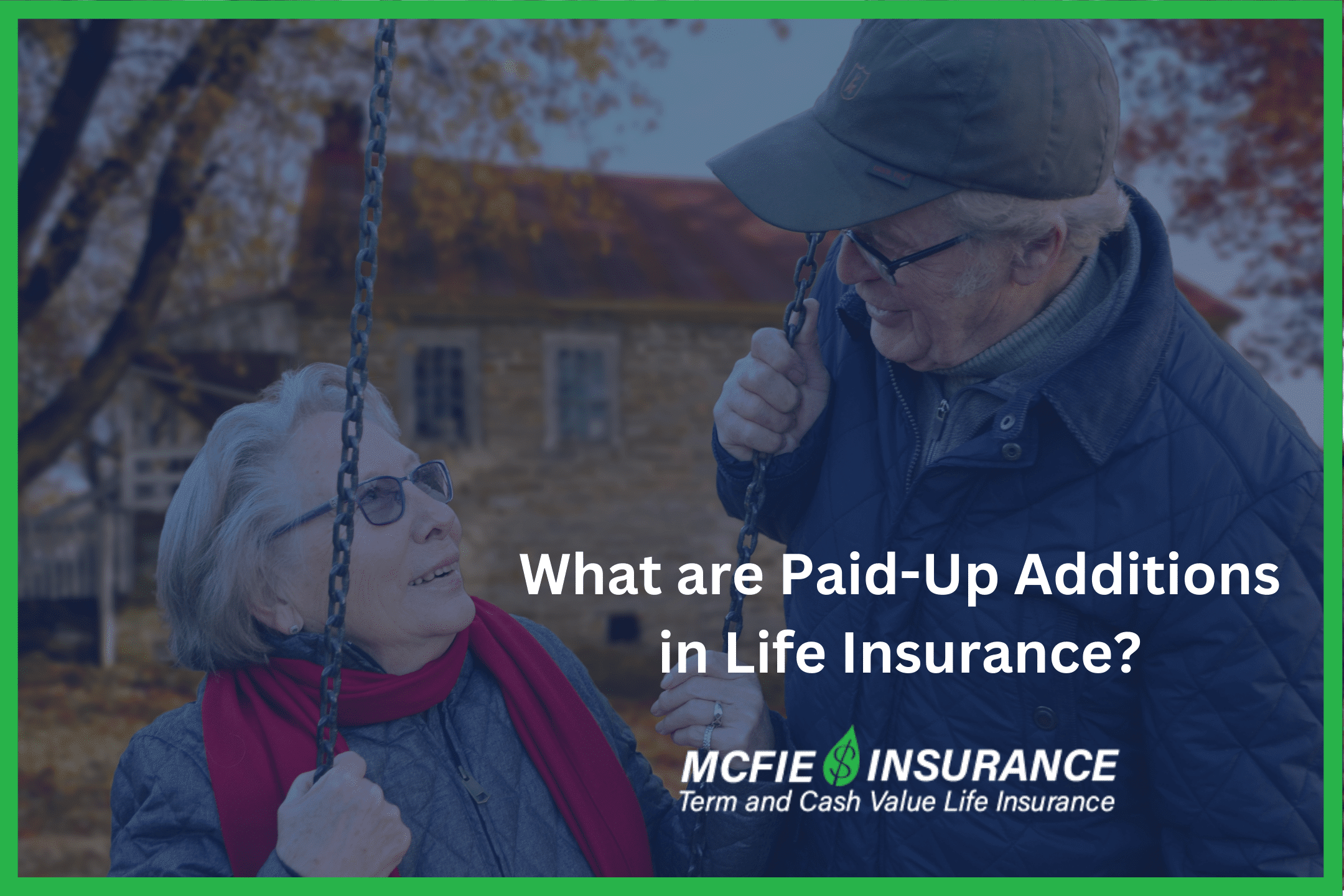317-912-1000
317-912-1000

In the insurance world, we use the term “paid-up” to talk about paid-up life insurance, paid-up additions rider, reduced paid-up insurance option, and a type of dividend option.
In a nutshell, paid-up life insurance allows you to pay life insurance premiums for a period of time (through a whole life insurance policy), then stop paying the premium and still reap some of the benefits of the life insurance policy.
The guarantees of most whole life insurance policies are based on an expected age of 100 or 121. This means that the policy will endow when you reach that expected age. “Endowment” is a fancy way to say that the death benefit and cash value of your policy are equal. If you are still living when the policy endows, then the policy simply stops growing. At this point, you’ll still have access to the cash value of the policy through a policy loan, withdrawal, or surrender, and your life will still be insured. The insurance company will continue insuring you after the policy endows until they receive a claim notification. Once a claim is made, the death benefit will be paid to your beneficiaries, and the insurance company will be finished fulfilling its contractual guarantees.
Premiums on whole life insurance policies are set by the insurance company based on the amount of insurance you are purchasing. The insurance company will also specify how long the premiums must be paid. It’s common for the insurance company to illustrate a stoppage of premiums, around age 75 – 90, on a whole life policy. The insurance company stops the premium like this when the policy has received enough funding for the insurance company to fulfill its guarantees for the remaining life of the contract. When a policy reaches this stage, it is called a paid-up life insurance policy. No more premiums are required after this point, yet the cash value and the death benefit will continue growing according to the insurance company’s guarantees.

Understanding the Infinite Banking Concept and How It Works In Our Modern Environment 31-page eBook from McFie Insurance Order here>
Even though a paid-up date has been determined by the insurance company, you can elect an early paid-up date for your policy. This is called a reduced paid-up life insurance option, and it works on the same principle as the paid-up option. With a reduced paid-up life insurance option, you can stop paying premiums on your policy, and the insurance company will continue fulfilling its guarantees in regard to the cash value and death benefit growth. The only difference with the reduced paid-up life insurance option is that the insurance company will also reduce the amount of death benefit in your policy. This is understandable because you are choosing to stop paying premiums early. Since you’re not going to be meeting the guaranteed premiums, the insurance company must also adjust the guaranteed death benefit.
Paid-up additions are one of our most recommended riders at McFie Insurance. We’re always excited to explain what paid-up additions can do for your life insurance policy. We’ve seen in our lives and in our clients’ lives how leveraging paid-up additions can benefit your finances. To start off, there are two ways to take advantage of paid-up additions. For one, you can add a paid-up additions rider. This is a provision that alters or adds to your policy that is only available through a whole life insurance policy. Secondly, you can choose the paid-up additions dividend option, meaning you pay for paid-up additions through your dividends on whole life insurance.
At McFie Insurance, we often work with clients who want more than just life insurance protection—they want a financial strategy. One of the most strategic ways to use whole life insurance is through the Infinite Banking Concept, a method that leverages the cash value in a properly structured whole life insurance policy to create a personal banking system.
The Infinite Banking Concept is not a product itself, but a strategy that uses high cash value whole life insurance—especially policies designed with significant paid-up additions—to create financial flexibility. The core idea is simple: you build cash value in your policy over time, then borrow against that cash value to finance major purchases, pay off debt, or invest in other opportunities, all while your policy continues to grow.
The key to making this concept work effectively is how the policy is structured from the beginning. We help clients tailor policies specifically for this purpose. That means emphasizing early cash value growth by incorporating paid-up additions through both riders and dividend options. These additions increase the cash value and death benefit more rapidly than traditional policies, making the policy more effective for Infinite Banking.
When structured properly, the policy becomes a flexible financial tool. Borrowing from your policy does not interrupt the compounding growth of your cash value, because the loan is secured against the policy, not withdrawn from it. This allows policyholders to maintain liquidity, earn dividends, and preserve long-term financial stability.
We’ve seen many clients benefit from this strategy over time. Whether it’s funding a business, purchasing real estate, or simply becoming less dependent on traditional banks, the Infinite Banking Concept—when executed correctly—can help put more control in your hands.
Our experience in building policies designed for this strategy reinforces our commitment to helping clients achieve both financial protection and flexibility. The right combination of base policy design and paid-up additions can turn a traditional life insurance policy into a lifetime financial asset.
A paid-up additions rider and the paid-up additionsdividend option are both purchasing paid-up additions. The difference is that a rider is paid through a designated portion of your premium and your dividend buys paid-up additions through the dividend option.
The paid-up additions dividend option is a wise way to use your dividend because of all of these benefits:
The rider is valuable because you can control how much you pay toward the paid-up additions in your premium, and it brings all the same benefits, but faster. We’ll go into more detail on all the benefits of paid-up additions (rider or dividend option) in the next section.
Let’s look over the benefits of paid-up additions. These apply to paid-up additions through a rider or a dividend option.
We don’t want you to feel like paid-up additions are pure magic. At the start, policies with the paid-up additions rider often have a lower death benefit than other policies without it. However, the paid-up additions make up for these lower values because it prepares your policy for so much growth.
How this looks: One of our clients opened a whole life insurance policy four years ago. Now he has a declared dividend of just below $20,450. If he had chosen to receive dividends in cash, instead of using them to buy paid-up additions, he would receive $20,450. But, since he opted for paid-up additions, he now has $61,900 of extra death benefit and an increased cash value of $20,900.
Tailor your policy for less premium payments: Whole life policies like our Custom Whole Life insurance let you decide the span of your premium-payment and amass cash value quicker than some other policies. Consequently, you might manage to fund your policy fully in just five to 10 years. Naturally, the lesser payments you commit to, the more substantial each premium will be.
Opt for reduced paid-up insurance: Should your coverage requirements shift down the road, you could potentially harness your dividends and any present cash value to buy a part of your coverage, hence decreasing future premium outlays. Picking this route means understanding that the eventual death benefit you’ll get will be notably less than the initial policy amount. A New York Life finance expert can offer thorough insights.
Benefit from paid-up additions: Many whole life policies stand to gain dividends, and this can be leveraged to secure extra coverage. Since the expense of this added coverage is entirely backed by the nonguaranteed dividends, it boosts your protection scope without upping premiums. Moreover, this new coverage too can reap dividends, leading to quicker growth of your policy’s worth every time dividends are announced.
After learning about paid-up additions in life insurance and understanding the benefits of paid-up additions, many people want a life insurance policy so they can enjoy these benefits in their own lives. Most people don’t have access to the illustration software to design their own policies with the right amount of paid-up additions and good cash value, so this is where we come in. If you would like to own a policy with good cash value and the right amount of paid-up additions, it would be our pleasure to design that policy for you. Click here to schedule your complimentary appointment.
 by Gracine McFie
by Gracine McFie
There are many ways to access information about finances, but it can be hard to determine which sources are trustworthy. I like to put information together in an accurate, straightforward, easy to understand manner so people can make good financial decisions based on the information provided without having to waste time wondering if the source is reliable.